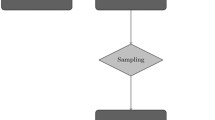Abstract
Research in the German National Educational Panel Study intends to provide the empirical basis for a longitudinal analysis of individuals’ educational careers and competencies and how they unfold over the life course in relation to formal as well as nonformal/informal learning environments. In order to track educational developments and decisions over the life span, six main samples serve as the foundation for the characterization and analysis of educational processes. These six main samples include newborns, Kindergarten children, secondary school children (fifth and ninth grade), first-year undergraduate students and adults. They are accompanied by several additional samples allowing an analysis of special groups, e.g., special needs pupils. Given that for several of the starting cohorts access to the target population is gained via educational institutions like Kindergartens and schools, multistage sampling approaches reflecting the multistage access to the target populations are implemented. Samples in individual contexts as for the cohorts of adults and newborns are established via register-based stratified cluster approaches. The designs of the implemented sampling strategies are shortly reviewed for each established sample.
Zusammenfassung
Die Forschungsintention des Nationalen Bildungspanels zielt auf die Bereitstellung der empirischen Grundlagen für eine fundierte längsschnittliche Analyse individueller Bildungsverläufe ab. Insbesondere steht die Abbildung individueller Kompetenzentwicklungen, unter besonderer Berücksichtigung des persönlichen und familiären Hintergrundes, sowie der Beziehung zu formalen Bildungsinstitutionen im Vordergrund. Zur Charakterisierung und Analyse von Bildungsentwicklungen und -entscheidungen über den gesamten Bildungsverlauf werden sechs Hauptstichproben etabliert. Diese Hauptstichproben werden jeweils als Zufallsstichproben aus den Kohorten der Neugeborenen, Kindern in Kindergärten, Kindern in der Sekundarstufe an allgemeinbildenden Schulen (fünfte und neunte Jahrgangsstufe), Erstsemesterstudierenden und Erwachsenen gebildet. Eine Ergänzung dieser sechs Hauptstichproben findet durch einige Zusatzstichproben statt, welche eine Analyse spezieller Gruppen erlauben, z. B. Kinder an Förderschulen. Da für etliche dieser Startkohorten des Nationalen Bildungspanels der Zugang zu den Zielpopulationen im institutionellen Kontext von Kindergärten und Schulen erfolgt, beruhen die entsprechenden Stichprobenziehungsverfahren auf einer mehrstufigen Zufallsauswahl, durch welche die institutionellen Gegebenheiten beim Feldzugang berücksichtigt werden können. Für Stichproben, bei denen die Erhebungen im individuellen Kontext stattfinden, erfolgt die Zufallsauswahl im Rahmen von registergestützten Klumpenstichproben. Die zur Anwendung kommenden Stichprobenziehungsverfahren werden kurz für alle zu etablierenden Stichproben dargestellt.
Similar content being viewed by others
References
Antoni, M., Drasch, K., Kleinert, C., Matthes, B., Ruland, M., & Trahms, A. (2010). Arbeiten und Lernen im Wandel, Teil I: Überblick über die Studie (FDZ-Methodenreport 5/2010). Nürnberg: Forschungsdatenzentrum (FDZ) der Bundesagentur für Arbeit im Institut für Arbeitsmarkt- und Berufsforschung.
Cochran, W. G. (1977). Sampling techniques (3rd ed.). Hoboken: Wiley.
Joncas, M. (2008). TIMSS 2007 sample design. In J. F. Olson, M. O. Martin, & I. V. Mullis (Eds.), TIMSS 2007 technical report (pp. 77–92). Chestnut Hill: TIMSS and PIRLS International Study Center.
Lavallée, P. (2007). Indirect sampling. New York: Springer.
Lohr, S. (2009). Sampling: Design and analysis (2nd ed.). Boston: Brooks/Cole.
OECD (2009). PISA 2006 technical report. Paris: OECD.
Särndal, C.-E., Swensson, B., & Wretman, J. (2003). Model assisted survey sampling. New York: Springer.
Thurgood, L., Walter, E., Carter, G., Henn, S., Huang, G., Nooter, D., Smith, W., Cash, R. W., & Salvucci, S. (2003). National Education Longitudinal Study of 1988 (NELS:88). In M. Seastrom, T. Phan, & M. Cohen (Eds.), NCES handbook of survey methods (pp. 53–66). Washington: U.S. Department of Education, National Center for Education Statistics.
Author information
Authors and Affiliations
Corresponding author
Rights and permissions
About this article
Cite this article
Aßmann, C., Steinhauer, H., Kiesl, H. et al. 4 Sampling designs of the National Educational Panel Study: challenges and solutions. Z Erziehungswiss 14 (Suppl 2), 51–65 (2011). https://doi.org/10.1007/s11618-011-0181-8
Published:
Issue Date:
DOI: https://doi.org/10.1007/s11618-011-0181-8
Keywords
- Panel study
- Multistage sampling
- Indirect sampling
- Explicit and implicit stratification
- Proportional to size sampling




